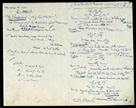Dickens's Manuscript and Number Plans
for Our Mutual Friend
Jon Michael Varese
The Dickens Project
University of California, Santa Cruz
Portions of the manuscript appear courtesy of the
Pierpont Morgan Library, New York. MA 1202-1203

Page 4 of the manuscript |

Page 14 of the manuscript |
The original manuscript and number plans of Our Mutual Friend reside in the Pierpont Morgan Library, New York. Our Mutual Friend is the only manuscript of a major Dickens novel that exists in the United States. Accounts from the late nineteenth and early twentieth centuries indicate that Dickens wrote the novel in blue ink on blue paper. While most of the blue ink still retains its vibrant color, a recent inspection of the manuscript revealed that the paper has faded to an off-white hue. The soil marks that damaged Part XVI of the manuscript in the Staplehurst train wreck have likewise faded from view. (See Dickens's "Postscript, In Lieu of Preface.") The manuscript and number plans, originally calf-bound by Dickens into two quarto volumes, were treated as part of a manuscript preservation project between 1978 and 1981, and rebound into multiple, more durable volumes. Each page of the manuscript and number plans is currently preserved in a transparent mylar casing within the new volumes.
The manuscript is written in Dickens's characteristic illegible long-hand. "The fineness and closeness of the writing," wrote Kate Field after inspecting the manuscript in 1874, "are enough to render the most amiable of experienced printers temporarily insane. There is no lover of Dickens so ardent as to willingly read a page through, nor would the most mercenary peruse both volumes for less than their weight in gold. Added to a microscopic chirography is erasure after erasure, such as, I am told, cannot be found in his earlier manuscripts, marking either greater care or less fluency of thought. Descriptions undergo most correction, and so deftly does Dickens cancel himself, that I defy the greatest expert to decipher what the author does not wish to have read...The erasures at the beginning of 'Podsnappery' are absolutely appalling" (Field, 472).
Dickens gave the manuscript as a gift of appreciation to his friend and fellow journalist Eneas Sweetland Dallas (1828-1879) after the appearance of Dallas's favorable review of Our Mutual Friend in The London Times. The flyleaf of the manuscript is signed and dated by Dickens on Thursday, January 4th, 1866. From this we surmise that Dickens presented the bound manuscript to Dallas two months after the publication of the last number (November 1865). Interestingly, the top portion of the flyleaf is torn away. Some have speculated that Dickens may have originally intended the manuscript for Forster (who was the recipient of most of Dickens's other manuscripts), but upon deciding to give it to Dallas, tore away the original inscription with Forster's name.
Sometime before August of 1874, the manuscript was acquired (presumably from Dallas) by George W. Childs of Philadelphia, a friend of the Dickens family. Childs later donated the manuscript to the Drexel Institute of Technology, Philadelphia. The Morgan Library purchased the manuscript from a sale that took place at the Drexel Institute on October 17-18, 1944.
SOURCES:
Field, Kate. "'Our Mutual Friend' in Manuscript." Scribner's Monthly, An Illustrated Magazine for the People, vol. VIII, August 1874, pp. 472-475.
Stone, Harry. Dickens' Working Notes for His Novels. Chicago: University of Chicago Press, 1987.
Morgan Library, Reading Room Card Catalogue.
